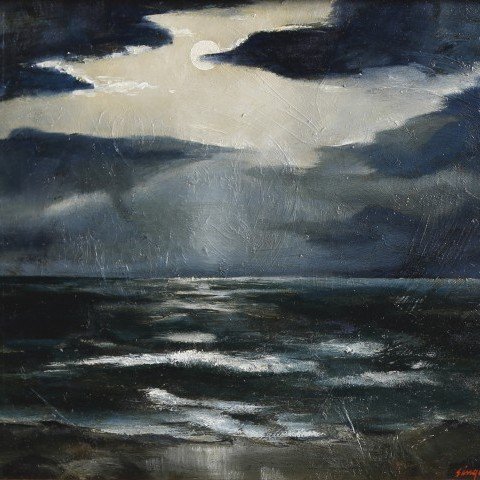Born in Malvern, Ohio, forty miles south of Akron, Clyde Singer became known for his regionalist paintings in oil and watercolor of people at carnivals, standing in bars, on windy street corners, celebrating holidays, or looking at pictures in a gallery. Many of his works are small, ones he calls his "bread and butter" paintings, and his style is reminiscent of Robert Henri and John Sloan, continuing through the well-known regionalists, John Steuert Curry and Grant Wood.
He has worked from his basement studio in Boardman, a suburb of Youngstown. He earned early recognition for his art talents including caricatures of his teachers. He was part of a family of seven children, and his father was a miner and farmer, and Clyde was regarded as the "different" one in the family and an oddity in a town of
one-thousand people.
In high school, he made signs for local farmers, and in his 20s, working for a sign company, he was assigned special displays such as the Christmas display on the Stark County Courthouse. Enrollment in the art school of the Columbus Gallery of Fine Arts (later the Columbus Museum of Art) directed him to a fine art career. In 1932 he returned to Malvern and created paintings that brought him much attention.
Shortly after, in 1933, he was awarded a scholarship to the Art Students League in New York. It was during the Depression, and he lived a Spartan existence. His teachers included John Steuert Curry, Thomas Hart Benton, Kenneth Hayes Miller, and Ivan Olinsky. Alexander Brook, also one of his instructors, got him a job painting a sign for a wine shop in Connecticut for twenty-five dollars, and Brook and his wife Peggy Bacon offered to help him financially, but he remained independent.
Adopting the Social Realist style, he tried to paint in the same locations as George Bellows and John Sloan, and he painted many scenes of the interior of McSorley's famous saloon that Sloan had depicted. As summer approached, Singer decided to return to his home state. Confiding this to Curry, the teacher said: "Oh, you're going home to paint the American scene! Good!
He returned with $1.10 in his pocket, and soon was painting signs again to make money, but in 1935, he sent a large canvas to the Chicago Art Institute and earned $500. 00 and the Harris silver medal. From that time, he entered major exhibitions including the Whitney Museum annual, the Corcoran Biennial, and the exhibitions at the National Academy of Design.
In 1940, he accepted a job from Joseph Butler III, director of the Butler Institute and a close friend. Singer continued his fine art painting, finishing over 3000 paintings during his career. At Butler's insistence, he also wrote the exhibition reviews for the local newspaper.
In 1941, he married Bernice Shimp, a former student of his from a class in Marietta, and from 1942 to 1945, he served in the Army in the Philippines, New Guinea, and Japan where he did a lot of sketching. After the war, he returned to employment with Butler, and they worked together until Butler's death in 1981.
Singer shared an office with Butler, taught classes, conducted tours of the exhibitions, acted as curator and co-director, and ran the museum when Butler took his long trips. He also continued painting daily and returned to New York at least once a year, so his paintings of New York are about as numerous as his paintings of Ohio. In 1981, Butler died, but Singer continued at the Institute.
Of his work he said: "Painting to me is the most fun there is"
Source: Article by Elizabeth McClelland published in "Little Bits of History, Clyde Singer, American Scene Painter" in TIMELINE, December 1966, a publication of the Ohio Historical Society

